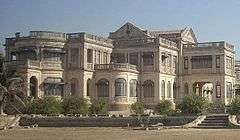Porbandar State
| Porbandar State પોરબંદર રિયાસત | |||||
| Princely State of British India | |||||
| |||||
|
Flag | |||||
 | |||||
| History | |||||
| • | Established | 1193 | |||
| • | merged into India | 1948 | |||
| Area | |||||
| • | 1931 | 1,647 km2 (636 sq mi) | |||
| Population | |||||
| • | 1931 | 115,673 | |||
| Density | 70.2 /km2 (181.9 /sq mi) | ||||
| | |||||
.jpg)

Porbandar State was a princely state during the British Raj. It was one of the few princely states with a coastline.
The capital of state was the harbour town of Porbandar.[1] Some other important towns of state were Bhanvad, Chhaya, Ranpar and Shrinagar. Earlier Ghumli served as the capital of Jethwas, which was lost to Jadejas, however, architectural heritage built by them still stands at Ghumli.[2] During the British Raj, the state covered[3] an area of 1,663 square kilometres (642 sq mi), encompassing 106 villages and a population, in 1921, of over 100,000 people. It enjoyed a revenue of Rs. 21,00,000/-.
History
In 1193 Porbandar State was founded by an ancestral ruler expelled from Morvi State. In 1307 the state was renamed 'Ranpur' and in 1574 it was renamed 'Chhaya'. Finally in 1785 the state reverted to the name Porbandar. On 5 December 1809 it became a British protectorate and between 1886 and 15 September 1900 the state was administered by Bombay Province.[4]
In 1888, during the reign of Vikramatji Khimojiraj, the State started metre-gauge railway called Porbandar State Railway, which after independence was merged in to Saurashtra Railway.[5]
Upon the Independence of India in 1947, the state acceded unto the dominion of India. It was merged with the 'United State of Kathiawar', effective from 15 February 1948 and eventually came to form part of the present-day state of Gujarat.[1]
Porbandar was the birthplace of Nationalist leader Mahatma Gandhi in 1869, whose ancestors served as Dewan (Prime Minister) to the State[6]
Rulers
Porbandar State was ruled by the Jethwa dynasty of Rajputs.[7] By 1947, the rulers held the style of "Highness" and the title of "Maharaj Rana Sahib";[1] they were entitled to a salute of 13 guns as a hereditary distinction.
Ranas
- 1699 – 1709 Bhanji Sartanji (d. 1709)
- 1709 – 1728 Khimoji III (d. 1728)
- 1728 – 1757 Vikmatji III Khimoji (d. 1757)
- 1757 – 22 April 1813 Sartanji II Vikmatji (d. 1813)
- 1804 – 1812 Haloji Sultanji -Regent (d. 1812)
- 22 Apr 1813 – 20 June 1831 Khimojiraj Haloji (d. 1831)
- 20 Jun 1831 – 21 April 1900 Vikramatji Khimojiraj (b. 1819 – d. 1900)
- 20 Jun 1831 – 1841 Rani Rupaliba Kunverba (f) -Regent (d. 1841)
- 21 Apr 1900 – 10 December 1908 Bhavsinhji Madhavsinhji (b. 1867 – d. 1908)
- 10 Dec 1908 – 1 January 1918 Natwarsinhji Bhavsinhji (b. 1901 – d. 1979)
- 10 Dec 1908 – 1909 Regents
- – J.K. Condon (to 1909)
- – Rao Bahadur A.S. Tambe (1909–1910)
- – Wala Vajsur Valera (1909–1913) (b. 1873 – d. 19..)
- – F. de B. Hancock (1913–1916) (d. 1916)
- – Edward O'Brien (Apr 1916 – 1918) (b. 1872 – d. 1965)
Maharaja Rana Sahib Shri
- 1 January 1918 – 15 August 1947 Natwarsinhji Bhavsinhji (s.a.) (from 3 June 1929, Sir Natwarsimhji Bhavsimhji)
- 1 January 1918 – 26 January 1920 Edward O'Brien -Regent (s.a.)
Administrators
- 1886 – 1890 Frederick Styles Philpin Lely (b. 1846 – d. 1934)
- 1890 – 1894 Shankar Pandurang Pandit
- Mar 1894 – 1896 William Thomson Morison
- Nov 1897 – 1900 Francis William Snell
See also
References
- 1 2 3 "PORBANDAR". www.royalark.net. Retrieved 10 December 2012.
- ↑ Gazetteer of the Bombay Presidency, Volume 8, 1884
- ↑ "Porbandar (Princely State)". www.maheronline.org. Retrieved 10 December 2012.
- ↑ Princely States of India
- ↑ "Porbandar railway".
- ↑ "Porbandar". www.britannica.com. Retrieved 10 December 2012.
- ↑ Rajput Provinces of India – Porbandar State (Princely State)
External links
 Media related to Porbandar State at Wikimedia Commons
Media related to Porbandar State at Wikimedia Commons
Coordinates: 21°37′48″N 69°36′00″E / 21.63000°N 69.60000°E

